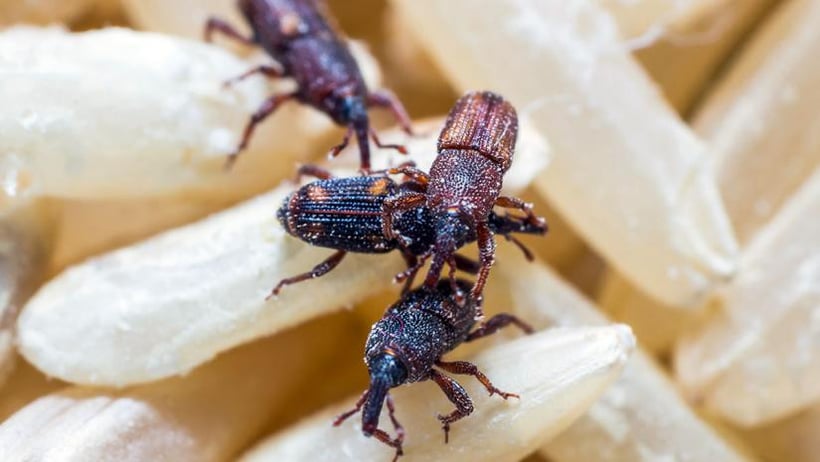
Flour, cereal, rice, pasta, cornmeal, powdered milk, nuts, popcorn, spices, baking mix: what do these foods have in common? Weevils are often found in all these dried goods!
Of the more than 1,000 species, the “stored product weevil” — so named because they infest stored grains, seeds and other dried food products — is the most frequently discovered weevil in food businesses. Weevils are a type of beetle, recognizable by their long snout and their preference for getting into these stashes of dried goods.
Weevils can be an expensive problem
Unlike other kinds of pests, the weevil doesn’t just find its way into food containers or bags — it actually lives inside the food, with the female chewing a hole into a grain of rice, for example, depositing an egg, sealing up the hole and leaving the egg behind. The larva then feeds on the grain until it’s fully grown, when the bug will eat its way out of the grain. Females emit pheromones that attract males, and the cycle continues.
Weevils can live for about eight months. While they’re not dangerous, they are certainly a nuisance — they contaminate food with their feces and cast skins, which makes whole packages or even pantries of food inedible.
It’s clear why a weevil infestation can be a major problem for a food business. Beyond being unsightly, eradicating an infestation is expensive, as the contaminated foods must be thrown out, causing food waste and mounting costs to the business.
Recognize a weevil infestation
While the eggs are almost invisible to the naked eye, grown weevils can be different colours, usually brown or black, and have different body shapes, with most being slender and oval-shaped. They are roughly three millimetres (mm) to more than 10mm long.
They’re usually found by observing dried goods and other foodstuffs in storage. Frequently check these foods to make sure they’re free of weevils.
Prevent a weevil infestation in your business
Prevent weevils from getting in by:
- Thoroughly checking deliveries: Any staff member receiving dried goods should inspect the delivery upon arrival. Open the lids to look closely at the product and check for small movements.
- Storing dry goods in tightly sealed containers: This will prevent weevils from getting in and stop contamination between foodstuffs.
- Cleaning and sanitizing containers between use: A good idea all the time, proper cleaning and sanitizing practices are especially helpful in preventing pests.
- Ensuring FIFO is followed: First In, First Out means first using items that were delivered earliest. The longer a dried good is untouched and unused, the more likely it will end up as a breeding ground for nasty pests!
What if you already have weevils?
If you know you already have weevils, you’ll need to identify the affected products and get rid of them. Your business’s Food Safety Program should instruct workers to check dry products regularly, and it should also include instructions on corrective actions to take if a pest problem is uncovered.
After you throw away affected products, you need to clean and sanitize the containers these products were stored in, and examine surrounding containers and areas of the business in case the weevils found their way in more foodstuffs than you initially realized.
Pests of any kind can be a serious problem for a food business. Whether you’re facing rodents, flies, cockroaches or weevils, the Canadian Institute of Food Safety (CIFS) can help you prevent and rid your premises of pests with our CIFS Guide to Pest Prevention and Control.
Frequently Asked Questions
What preventive measures can be taken at the supplier level to minimize the risk of weevil contamination in food products?
At the supplier level, preventive measures to minimize the risk of weevil contamination in food products include rigorous inspection of goods before shipment, using proper storage methods like temperature-controlled environments to inhibit weevil growth and ensuring cleanliness in storage facilities to prevent infestations.
Suppliers can also use pest control barriers and regularly check for signs of infestation, such as damaged grains or the presence of weevils, to address issues before products are distributed to retailers or food businesses.
Are there any specific seasonal considerations that impact the prevalence of weevils in food businesses?
Yes, seasonal considerations can significantly impact the prevalence of weevils in food businesses. Warmer months typically see a higher activity level of weevils due to favorable breeding conditions.
Humidity and temperature can both contribute to weevil infestation risks, making it essential for food businesses to enhance their pest control measures during these periods. Proper storage and handling of susceptible products, particularly grains and flours, are crucial year-round but especially so in warmer conditions.
What are the best practices for disposing of products and materials infested with weevils to prevent further spread within the facility?
The best practices for disposing of products and materials infested with weevils to prevent further spread within a facility include sealing infested goods in secure, airtight containers or sturdy plastic bags before removal to avoid contaminating other areas. It's important to dispose of these items immediately and away from the main storage or production areas.
Additionally, thorough cleaning and sanitizing of the affected area and surrounding spots are crucial to eliminate any remaining eggs or larvae.





